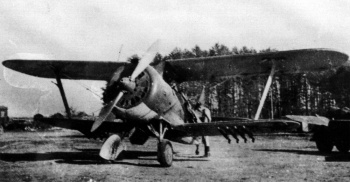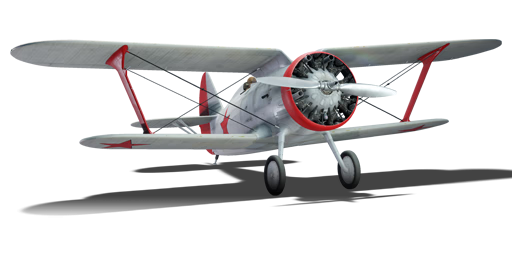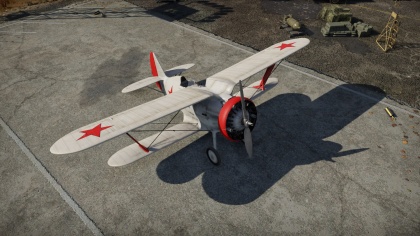I-15 M-25
Contents
| This page is about the Russian fighter I-15 M-25. For other uses, see I-15 (Family). |
Description
The I-15 M-25 is a rank I Russian fighter
with a battle rating of 1.0 (AB/RB/SB). It has been in the game since the start of the Open Beta Test prior to Update 1.27.
The I-15 R is a single-engine fighter developed from the OKB Polikarpov I-15 (TsKB-3) for a 1935 release. Attempt to introduction the Soviet license modification of the Wright Cyclone SGR-1820 engine under the designation M-25 was progressing very slowly, therefore most of the production I-15 aircraft at this time were outfitted with the 9-cylinder Gnome et Rhône air-cooled M-22 engines (the licensed version of the British Bristol Jupiter VI) which had a nominal power of only 480 hp, which caused this aircraft’s flight performance to suffer. While on the final production series of this aircraft the M-25 engines were installed, this version of the aircraft in-game features the weaker M-22 engine.
General info
Flight Performance
The I-15 M-22 has decent performance as a reserve fighter even with the lacklustre M-22 engine. This aircraft will often get into aerial engagements averaging with a 1.0 battle rating, however, the I-15 M-22 can still be a formidable machine, even in the hands of a novice:
- Rate of climb - Among the reserve aircraft, the I-15 does not have the best performance in climb rate, but because early matches consist of low-level dog-fights which take place at +/- the same height, this is not an issue.
- The top speed of this fighter is not a record characteristic of the “Seagulls”. While it is possible to catch up to and overtake the German He.51, most of the other remaining reserve aircraft are superior to this Soviet fighter, especially aircraft reaching into the Battle ratings of 1.3-2.0,
- While lacking advantages with speed and rate of climb, manoeuvrability is one of the best advantages in the game for this aircraft in early matches. In fact, due to the quick turn time, the “Seagull” pilot is able to outmanoeuvre many other early aircraft in the game.
| Characteristics | |||||||
|---|---|---|---|---|---|---|---|
| Stock | |||||||
| Max Speed (km/h at 3,000 m) |
Max altitude (meters) |
Turn time (seconds) |
Rate of climb (meters/second) |
Take-off run (meters) | |||
| AB | RB | AB | RB | AB | RB | ||
| 358 | 348 | 9200 | 8.1 | 8.7 | 10.5 | 10.5 | 125 |
| Upgraded | |||||||
| Max Speed (km/h at 3,000 m) |
Max altitude (meters) |
Turn time (seconds) |
Rate of climb (meters/second) |
Take-off run (meters) | |||
| AB | RB | AB | RB | AB | RB | ||
| 379 | 368 | 9200 | 7.9 | 8.0 | 16.9 | 13.4 | 125 |
Details
| Features | ||||
|---|---|---|---|---|
| Combat flaps | Take-off flaps | Landing flaps | Air brakes | Arrestor gear |
| ✓ | X | X | X | X |
| Limits | ||||
|---|---|---|---|---|
| Wing-break speed (km/h) |
Gear limit (km/h) |
Combat flaps (km/h) |
Max Static G | |
| + | - | |||
| 520 | ~11 | ~4 | ||
| Optimal velocities | |||
|---|---|---|---|
| Ailerons (km/h) |
Rudder (km/h) |
Elevators (km/h) |
Radiator (km/h) |
| < 180 | < 360 | < 260 | > 180 |
| Compressor (RB/SB) | ||
|---|---|---|
| Setting 1 | ||
| Optimal altitude | 100% Engine power | WEP Engine power |
| 1,000 m | 570 hp | N/A |
Survivability and armour
Early attempts to protect the pilot outfitted the aircraft with a 9-mm armoured backrest. Although many of the planes encountered in early battles and other I-15s do not have any armour at all, the survivability of the Seagull leaves much to be desired - unprotected fuel tanks can catch fire while fragile wings and fuselage can easily detach from a relatively short burst of a machine gun or cannon fire. Owing to an inefficient cooling system, the player is forced to make full use of the manoeuvrability of the aircraft.
Armaments
Offensive armament
The I-15 M-25 is armed with:
- 4 x 7.62 mm PV-1 machine guns, nose-mounted (750 rpg = 3,000 total)
The I-15 is armed with 4 x PV-1 machine guns with a total ammunition load of 3,000 rounds. The damage dealt from these machine guns is not bad, especially against biplanes and early wooden monoplanes, however, with opponents having a greater battle rating, the pilot will need to test different options to see what works best for them. Recommended belts for this aircraft are either universal or tracers. While using an all tracer belt does not seem as powerful as the universal belt, they are extremely effective against early aircraft by lighting fuel tanks on fire, knocking out pilots and are extremely easy to use for new pilots as they will be able to see where all of their rounds are going and adjust fire to compensate when necessary. For the advanced pilot who wants to exercise the element of surprise, Stealth belts are the way to go.
Suspended armament
The I-15 M-25 can be outfitted with the following ordnance:
- Without load
- 2 x 50 kg FAB-50 bombs (100 kg total)
Under the wings of the "Seagull", you can hang 2 x 50 kg FAB-50 bombs. Choices are very limited with early aircraft due to the amount of weight they can haul. Overall bomb damage is mediocre, requiring the pilot to drop their ordnance exactly on the enemy vehicles to maximize the chance for destruction or at the least, disabling of the vehicle. This aircraft is not meant to be a bomber, however, it does have the opportunity selectively take out soft targets on the battlefield such as mobile anti-aircraft vehicles and anti-aircraft artillery sites.
Usage in battles
In aerial realistic battles, the use of gulls is very simple - removing the enemy fighters chasing the tail of allied fighters who failed to gain altitude. Doing so can make a high contribution to the development of the battle and seriously influence its outcome. During tank battles, the “Seagull” pilot can utilise the FAB-50 bombs to attack softer enemy armoured vehicles (if you practice, you can learn how to drop bombs accurately), and with the help of machine guns you can destroy equipment with open tops, exposed crews and various anti-aircraft guns and self-propelled guns from enemy air attacks.
I-15 is not bad for beginners who have just begun to master aviation - excellent manoeuvrability and good armament provide high chances for success in shooting down the enemy during frequent “Dogfights” in the lower battle rated matches. The main thing to remember for the I-15 pilot is the inefficient cooling system - even on winter maps, the plane is prone to overheating when continuously using the engine at 100%. Outside the active combat phase, it is better to lower the flight power to between 92-95% to preserve your engine for when you really need it.
With 3,000 rounds of ammunition, you can afford to shoot with low accuracy, especially if you are just learning how to fly and shoot, beware though even with that much ammunition it is very easy to run through all the bullets if you continuously hold down the firing trigger.
This fighter is relatively easy to destroy, however, you should be careful to face this enemy in a 1 vs 1 as this fighter does very well in a turn fight.
Manual Engine Control
| MEC elements | ||||||
|---|---|---|---|---|---|---|
| Mixer | Pitch | Radiator | Supercharger | Turbocharger | ||
| Oil | Water | Type | ||||
| Controllable | Not controllable Not auto controlled |
Not controllable Not auto controlled |
Controllable Not auto controlled |
Separate | Not controllable 1 gear |
Not controllable |
Modules
| Tier | Flight performance | Survivability | Weaponry | |
|---|---|---|---|---|
| I | Fuselage repair | Radiator | Offensive 7 mm | |
| II | Compressor | New 7 mm MGs | ||
| III | Wings repair | Engine | Airframe | DZ-40 |
| IV | Cover | |||
Pros and cons
Pros:
- Excellent manoeuvrability.
- Excellent turn fighter/dog fighter
- Good weapons
- Huge ammunition pool, 3,000
- Excellent beginner aircraft to learn to fly and shoot, very forgiving
Cons:
- Inefficient cooling system
- Fragile construction
- Low speed
- In realistic and simulator battles, wings can break in a dive or turn exceeding 290km/h
History

The aircraft was initially developed in 1933 as a further development of the I-5 and I-6 with a specific focus in improving aerodynamics. On the first production aircraft set, the I-15 WR utilised the Wright Cyclone SGR-1820 F-3 engine which had a nominal power of 630 hp on the ground. In 1934 there was still no serial M-25 Soviet licensed engine, so the less powerful M-22 had to be installed (the licensed version of the Bristol Jupiter) - several hundred copies of them were produced in 1934-1936. In 1935, the aircraft was adopted by the Red Army Air Force as their premier combat aircraft. In 1936, only 12 combat vehicles were manufactured, however, in 1937, the I-15 went to serial production with the new M-25 engines. In the 30s, the aircraft had no equal manoeuvrability on the horizontal (8-8.5 s. turning time), was stable in all flight modes, easy to fly and had good takeoff and landing qualities. In the words of Colonel E. N. Stepanov, who fought with this aircraft in Spain and committed the world's first night ramming with the I-15 stated that “it is possible with a certain skill to catch up with your tail in a turn”. This aircraft had good repair properties and vitality.
Further development of the I-15 became the I-15bis and I-153 "Seagull."
The good rate of climb of the I-15 allowed it to be used as a high-altitude fighter. On the first prototype of the I-15, after special training (maximally facilitating the construction and installation of a Wright Cyclone F-54 high-altitude engine), pilot V.K. Kokkinaki on November 21, 1935 exceeded the absolute world record of flight altitude, gaining 14,575 meters, unfortunately, it wasn’t until 1936 that Soviet FAI records were recorded. Since 1937, work began on equipping the I-15 with a pressurized cabin, which made it possible to make fuller use of the height characteristics. The I-15GK and I-153GK were tested with Shcherbakov's cabin and several Polikarpovskiy’s less successful I-15V variants. All variants with a pressurized cabin remained only in experimental status and never went into production. Combat use:
- 1936 – 1939 The Spanish Civil War - Used under the name Chato as a fighter, attacker, and reconnaissance aircraft. In total, 368 aircraft of this type were used in Spain. This fighter went down in history as one of the best fighters in the world during this period of time.
- 1937 Second Sino-Japanese War – Used as a fighter. The I-15 worked together with the I-16 and utilised their talents with high-speed and manoeuvrability to shine in combat. In the summer of 1938, it was used in battles at Lake Hassan. 1939 - fighting in Mongolia on the Khalkhin Gol River, again was used as a fighter aircraft in conjunction with the I-16. Time was catching up to the I-15 as during battles with Japanese fighters it showed to have lost its manoeuvrability advantage and was starting to be bested by modern Japanese fighters.
- 1941 - Used at the beginning of the Great Patriotic War.
- 1947 - 1948 - Mongolian-Chinese border conflict, as well as the Mongolian-Eastern Turkestan border conflict.
In-game description
Polikarpov I-15 (TsKB-3) single-engine fighter, produced in 1935
The launch of the Soviet licensed version of the Wright Cyclone SGR-1820 engine, under the designation M-25, was quite drawn out; therefore, a majority of production I-15s were equipped with M-22 (a licensed version of the British Bristol Jupiter VI) nine-cylinder, air-cooled engines, whose rated power was only 480 hp. This significantly worsened the plane's flight characteristics.
Aircraft from the final production series had M-25 engines. In addition, they had one more pair of 7.62 mm synchronous PV-1 machine guns.
Most I-15s had fixed-pitch propellers, but some machines received VISh-6 controllable-pitch propellers.
In Spain, in the autumn of 1936, the I-15 fighter was used for the first time in the field. The first air battle involving an I-15 took place on November 4. A total of 186 I-15 fighters were received by the Republicans from the USSR.
I-15 fighters were also used in the Khalkhyn Gol frontier conflict, in the Winter War of 1939-40, and even during the initial period of World War II (mainly as ground-attack aircraft). However, the plane was considered obsolete even by the Battle of Khalkhyn Gol.
Stable and handy, with good flight characteristics, exceptional manoeuvrability, and excellent takeoff/landing parameters, the I-15 fighter enjoyed a well-deserved success among pilots.
Some I-15 fighters were used as personal command vehicles. For example, a drawing of a flying red banner with the words "FOR VKP (B)", i. e. "For the All-Union Communist Party (of Bolsheviks)", was applied to the fuselage of the personal I-15 of Brigade Commander I. U. Pavlov, and a bent white arrow directed down was painted on the red rudder. The metal skin of the nose fuselage was polished in a frost pattern.
On November 21, 1935, the test pilot V. K. Kokkinaki established the world's unofficial (as the USSR was not yet a member of the FAI) flight altitude record of 14,575 m while flying a special TsKB-3 with a reduced weight.
The I-15's manoeuvrability was excellent, and its short fuselage and large control surfaces ensured the fighter's agility. Not a single major rival of the I-15 in Spain (neither the German He 51 fighter nor the Italian CR.32) was its equal in these characteristics.
The I-15's full-scale production was discontinued in 1936. A total of 384 aircraft were manufactured at Factories No. 1 and No. 39 from 1934-36. In addition, 291 more aircraft were built under licence in Republican Spain.
Media
Excellent additions to the article would be video guides, screenshots from the game, and photos.
See also
Links to the articles on the War Thunder Wiki that you think will be useful for the reader, for example:
- reference to the series of the aircraft;
- links to approximate analogues of other nations and research trees.
External links
Paste links to sources and external resources, such as:
- topic on the official game forum;
- encyclopedia page on the aircraft;
- other literature.
| Polikarpov Design Bureau (Опытное конструкторское бюро Поликарпова) | |
|---|---|
| I-15 | I-15 WR · I-15 M-22 · I-15 M-25 · I-15bis · Krasnolutsky's I-15bis |
| I-153 | I-153 M-62 · Zhukovsky's I-153-M62 · I-153P |
| I-16 | I-16 type 5 · I-16 type 10 · I-16 type 18 · I-16 type 24 · I-16 type 27 · I-16 type 28 |
| I-180 | I-180S · I-185 (M-71) · I-185 (M-82) |
| ITP | ITP (M-1) |
| Twin-engine fighters | TIS MA |
| Bombers | Po-2 · Po-2M |
| Export | ␗I-15bis · ␗I-153 M-62 · ␗I-16 type 5 · ␗I-16 type 10 · ␗I-16 type 17 · ␗I-16 Chung 28 |
| USSR fighters | |
|---|---|
| I-15 | I-15 WR · I-15 M-22 · I-15 M-25 · I-15bis · Krasnolutsky's I-15bis |
| I-153 M-62 · Zhukovsky's I-153-M62 · I-153P | |
| I-16 | I-16 type 5 · I-16 type 10 · I-16 type 18 · I-16 type 24 · I-16 type 27 · I-16 type 28 · I-180S |
| I-29 | I-29 |
| I-185 | I-185 (M-71) · I-185 (M-82) |
| I-225 | I-225 |
| ITP | ITP (M-1) |
| MiG-3 | MiG-3-15 · MiG-3-15 (BK) · MiG-3-34 |
| LaGG | I-301 · LaGG-3-4 · LaGG-3-8 · LaGG-3-11 · LaGG-3-23 · LaGG-3-34 · LaGG-3-35 · LaGG-3-66 |
| La | La-5 · La-5F · La-5FN · La-7 · Dolgushin's La-7 · La-7B-20 · La-9 · La-11 |
| Yak-1/7 | Yak-1 · Yak-1B · Yak-7B |
| Yak-3 | Yak-3 · Eremin's Yak-3(e) · Yak-3P · Yak-3T · Yak-3U · Yak-3 (VK-107) |
| Yak-9 | Yak-9 · Yak-9B · Golovachev's Yak-9M · Yak-9T · Yak-9K · Yak-9U · Yak-9UT · Yak-9P |
| Other countries | ▂P-40E-1 · ▂P-47D-27 · ▂Hurricane Mk IIB · ▂Fw 190 D-9 · ▂Spitfire Mk IXc |
| P-39 | ▂P-39K-1 · ▂Pokryshkin's P-39N-0 · ▂P-39Q-15 |
| P-63 | ▂P-63A-5 · ▂P-63A-10 · ▂P-63C-5 |





